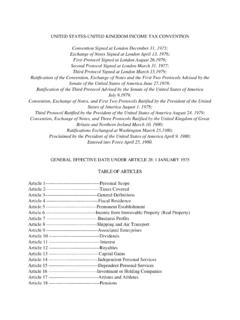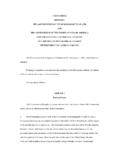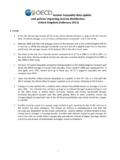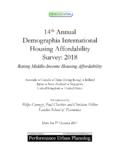Transcription of How does the UNITED KINGDOM compare? …
1 OECD Employment Outlook 2018 OECD 2018 OECD Employment Outlook publication page How does the UNITED KINGDOM compare? Employment Outlook 2018 July 2018 DOI: market developments in the UNITED KINGDOM Note: OECD weighted average (based on 29 OECD countries in Panel B, not including Chile, Iceland, Korea, Mexico, New Zealand and Turkey). Source: OECD calculations based on OECD Economic Outlook Database (No. 103), June 2018, and quarterly national LABOUR MARKET TRENDS AND PROSPECTS Across the OECD countries, labour market conditions continue to improve and in the first quarter of 2018, the average employment rate was about 2 percentage points above its pre-crisis peak. OECD employment and unemployment rates are also projected to keep improving in 2018 and 2019. However, at in the fourth quarter of 2017, the year-on-year growth rate of real hourly wages remained disappointingly low, almost one percentage point lower than before the crisis for similar levels of unemployment.
2 The UK headline employment indicators compare well with OECD averages. In the first quarter of 2018, the UK employment rate of those aged between 15 and 74 years was , the highest UK level on record and about 5 percentage points above the OECD average. The UK unemployment rate of 4. 1% is also well below the OECD average ( ). The employment rate is projected to remain constant at throughout most of 2018 and 2019. However, a slight deterioration of labour market conditions is expected to increase the unemployment rate to , bringing it closer to the OECD average of by the end of 2019. DEVELOPMENTS IN JOB QUALITY AND LABOUR MARKET INCLUSIVENESS Job quality and inclusiveness indicators show a mixed picture for the OECD countries. Improvement has occurred over the past decade, with a reduction in the gender gap in labour income, the employment gap for disadvantaged groups, and the incidence of job strain excessive job demands combined with insufficient resources.
3 However, labour market insecurity is not yet back to pre-crisis levels and poverty has grown amongst the working-age population. The UK labour market performs above the OECD average in all key indicators of job quality and inclusiveness, except the gender gap in labour income (see the chart on the next page). Labour market insecurity is lower than the OECD average, mainly due to the low unemployment rate. Further, the incidence of job strain among workers, at , is the fourth lowest of the 32 OECD countries for which these data are available. The frequency of low incomes is close to the OECD average, with 10% of working-age persons living with less than 50% of the median income. This reflects a relatively high proportion of working-age households which are jobless or have low market incomes, with net incomes augmented by means-tested benefits.
4 Employment rates for several disadvantaged groups remain significantly below those of prime-age men, but the average gap is smaller in the UK than in many other countries: both a cause and a consequence of the relatively high overall employment rate. WAGELESS GROWTH REQUIRES A MORE INCLUSIVE APPROACH TO LABOUR POLICY The current, unprecedented period of slow wage growth hides significant differences among workers, 56586062646668% UNITED KingdomOECD-4-20246%B. Real hourly wageYear-on-year percentage change, trended seriesA. Employment ratePercentage of the population aged 15-74 ProjectionsContacts: Marguerita Lane (+33 1 85 55 47 89; or Mark Pearson (+33 1 45 24 92 69; Directorate for Employment, Labour and Social Affairs. OECD Employment Outlook publication page OECD Employment Outlook 2018 OECD 2018 Job quality and labour market inclusiveness: key indicators for the UNITED KINGDOM in 2016-2017 Note: An upward (downward ) pointing arrow for an indicator means that higher (lower) values reflect better performance.))
5 Earnings quality: Gross hourly earnings in USD adjusted for inequality by giving more weight to the lower end of the earnings distribution. Labour market insecurity: Expected percentage net income loss upon job loss computed taking into account the probability of becoming unemployed and the expected duration of unemployment. Job strain: Percentage of workers in jobs with a combination of high job demands and few job resources to meet those demands. Low income rate: Share of working-age persons living with less than 50% of median equivalised household disposable income. Gender labour income gap: Difference between per capita annual earnings of men and women (% of per capita earnings of men). Employment gap for disadvantaged groups: Average difference in the prime-age men's employment rate and the rates for five disadvantaged groups (mothers with children, youth who are not in full-time education or training, workers aged 55-64, non-natives, and persons with disabilities; % of the prime-age men's rate).
6 Source and definitions: OECD calculations using data for 2017 or latest year available from various sources. See OECD Employment Outlook 2018, Ch. 1with a greater impact on vulnerable individuals, who are more prone to experience spells of unemployment or precarious jobs. Greater policy effort is required to ensure that all workers are provided with opportunities to develop, maintain and upgrade their skills, thereby reducing the risk of becoming trapped in low-wage, low-quality jobs and joblessness. Real wages declined in the UNITED KINGDOM during the crisis (as shown in Panel B of the chart on the previous page), as in euro area countries hit hard by the sovereign debt crisis, such as Portugal, Spain, Italy and Greece. Wage growth in 2017 was lower relative to pre-recovery periods with comparable levels of unemployment.
7 The same was true in Ireland and the UNITED States. Labour productivity, which has remained flat in the UK since the financial crisis, needs to be revitalised in order to boost international competitiveness and real wages. The government s strategy should focus on reducing regional productivity gaps, which are high in the UK, and improving the skill set of low-skilled individuals in the workforce via reforms to formal education, technical education and the apprenticeship system. THE GENDER GAP IN LABOUR INCOME INCREASES THROUGHOUT THE WORKING LIFE In the OECD, women's annual labour income was still 39% lower on average than that of men in 2015. Most of this gap is generated in the first half of the career, due to intermittent employment and difficulties in reconciling work and family responsibilities around childbirth.
8 Part-time work can prevent withdrawal from the labour force at childbirth but may also represent a career trap for women, leading to persistent gender disparities. The average annual labour income of British women was smaller than that of men in 2015, a figure greater than the OECD average. The gender gap in hours worked is one of the key drivers. The share of British women in employment holding a part-time job was over three times that of men in 2016, one of the highest ratios in the OECD. The tax treatment of couples, and childcare costs combine to create a powerful disincentive to work full-time for second-earners. The supply of affordable childcare should be scaled-up in order to ensure women who wish to work full time can do so. Mexico: USDD enmark: USDOECD: USDU nited KINGDOM : USDE arnings quality ( )Greece: : KINGDOM : market insecurity ( )Greece: : : KINGDOM : strain ( )Greece: 16%Czech Rep.
9 : : KINGDOM : 10%Low-income rate ( )QualityKorea: 61%Finland: : KINGDOM : : : : KINGDOM : labour income gap ( )Employmentgap for disadvantaged groups( )InclusivenessBottom performerTop performer
















